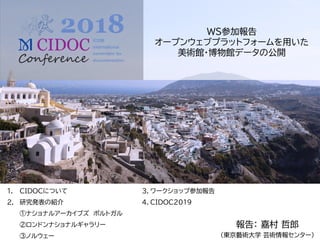ICOM CIDOC2018参加報告
- 1. WS参加報告 オープンウェブプラットフォームを用いた 美術館?博物館データの公開 1. CIDOCについて 2. 研究発表の紹介 ①ナショナルアーカイブズ ポルトガル ②ロンドンナショナルギャラリー ③ノルウェー 3.ワークショップ参加報告 4.CIDOC2019 報告: 嘉村 哲郎 (東京藝術大学 芸術情報センター)
- 2. 国際博物館会議 ドキュメンテーション国際委員会 CIDOC(International Committee for Documentation) ① Archaeological Sites 遺跡や考古学要因を含む場所の記録やドキュメンテーション標準化 ② Co-reference 異なる表記の語が同一の内容を示す場合,それぞれの語に対して同一性と一意性をどの ように識別或いはデータとして定義するのか。デジタル時代の典拠情報に関する研究を 行うグループ。 ③ CRM Special Interest Group 博物館情報のデータモデルCIDOC CRMの仕様策定と普及活動。 ④ Exhibition and Performance Documentation 展覧会および舞台芸術に関するドキュメンテーションの研究?調査。 メタデータの標準化やデジタル化,保存管理に関する内容も扱う。 ⑤ Digital Preservation デジタルデータや資料のデジタル化と保存に関する諸問題を扱う。 長期的なデータ保存に対する研究?調査を行っている。
- 3. ⑥ Documentation Standards 博物館資料の情報分類や統制語彙,専門辞書の利用に関する指針を調査?研究。 ⑦ Intangible Cultural Heritage 無形文化財に関するドキュメンテーション標準やガイドラインの策定を行う。 ⑧ Information Centres 世界各地の博物館情報に関するサービスや標準を研究?調査するとともにCHINやCTなど 各国の関連団体と情報交換?連携を行う。 ⑨ Museum Process Implementation 博物館の運営に関する業務手続きや各種作業手順の標準化を進めるグループ (SPECTRUMで言う"SPECTRUM procedure"の”object entry”等)。 ⑩ LIDO(Lightweight Information Describing Objects) CDWA LightとMuseumdatをベースにした博物館資料情報記述のための軽量メタデー タスキーマの策定?普及活動を行うグループ。 ? Semantic Research Environments Semantic Webに関する研究事例や博物館に関するドメインオントロジを調査研究。
- 6. メイン会場 Cultural Conference Centre of Heraklion 9月29日:ボードミーティング 9月30日:ワークショップ 10月1日?4日:年次大会?総会 10月5日:オプショナルツアー
- 7. 大会テーマ:Provenance of Knowledge ① Documentation: Models, Tools and Technology CIDOC-CRMやLIDO、セマンティックWeb、データベース等、博物館情報をデータで扱う 方法論やデータ構造を議論。情報科学向けの研究発表内容。 ② Provenance and Documentation コレクションの来歴に関する記述を中心に議論が展開された。今回は現物資料の来歴に加え てデジタルデータの作品?資料の記述やデータ管理の検討が行われていた点は特徴的。 ③ Innovation in Documentation 画像データの来歴や人々の社会的記憶?記録のドキュメンテーション等。 デジタルを意識した現代的なドキュメンテーションについて議論が行われていた。 ④ Special Session CIDOC-CRM、Getty Vocabularies、Wikimedia、SPECTRUM等のデータ標準や データモデルに関して議論する複合的なセッション
- 8. ICON Project: content integration in Portuguese national archives using CIDOC-CRM
- 26. <crm:P48.has_preferred_identifier rdf:nodeID="id_000-01D6-0000"/> <crm:P50.has_current_keeper rdf:resource="001-02VZ-0000"/> <crm:P55.has_current_location rdf:resource="006-001M-0000"/> <crm:P102.has_title rdf:resource="00C-01C7-0000"/> <crm:P43.has_dimension rdf:nodeID="width_000-01D6-0000"/> <crm:P43.has_dimension rdf:nodeID="height_000-01D6-0000"/> <crm:P2.has_type rdf:resource="00A-00BP-0000"/> <crm:P46.is_composed_of rdf:nodeID="medium_000-01D6-00000"/> <crm:P46.is_composed_of rdf:nodeID="support_000-01D6-00000"/> <rdf:Description rdf:about="006-001M-0000"> <rdf:type rdf:resource="crm:E53.Place"/> <rdfs:label xml:lang="en">Room 30</rdfs:label> <rdfs:comment xml:lang="en">Spanish painting flourished during the 17th century principally in the service of God and King. The evolution of a Catholic Counter-Reformation religiosity is revealed in a variety of powerful, individual styles. Not long after El Greco had portrayed the divine with ethereal idealisations of figures, space and light, Diego Velázquez and Francisco de Zurbarán turned to realism to represent the mystical. To make religion more personally relevant, they used naturalistic light to convey divine presence and they depicted the saints as ordinary people, with a vivid physicality and facial expressions. Taste changed after 1650, and Bartolomé Esteban Murillo appealed to popular piety with an ideal style of soft forms and colours, and a sweet and gentle mood. At the court of Philip IV, Velázquez transformed his style of earthy realism in order to express the dignity and splendour of the monarchy. He developed an elegant technique of artful brushwork that calls attention to itself and yet conveys compelling actuality when viewed from a distance.</rdfs:comment> <crm:P102.has_title rdf:nodeID="title_006-001M-0000"/>
- 31. データ化范囲と内容
- 38. Yale Centre British Art CIDOC-CRMとWikidataの組み合わせ
- 40. CIDOC CRM + Linked Open Usable Data 写真データのデータモデリング例 用語定義にGetty AATを利用 モノクロ写真: aat:300128359
- 41. ? クレタ島 = CIDOC CRM開発拠点 ? CIDOC CRMに関する発表多数 ? LODによるデータ公開を前提とした情報記述や手続き ? 博物館情報にVIAFやWikidata、Gettyシソーラスなど、 オンライン上の情報を統合して扱う傾向が高まっている。 所感
- 42. Make your museum more visible with Wikimedia projects
- 44. オープンプラットフォーム
- 53. 少ない労力で情报をリッチに!!
- 54. 无偿で使えるメディアリポジトリ
- 56. Open GLAM Work flow
- 67. Category:Tokyo University of the Arts, The GEIDAI Archives https://commons.wikimedia.org/wiki/Category:Tokyo_University_of_the_Arts,_The_GEIDAI_Archives
- 72. 会場 : 国立京都国際会館(ICC Kyoto)
- 73. CIDOC2019テーマ&発表者募集中!! ① 検索インデックスと表記 語の揺らぎ、記述、読み仮名の問題。 ② 言語?意味の解釈 ことばの意味の問題。同じ字面の用語1つをもっても、考古と美術史で異なる解釈をする等、言語や用語等 の意味の問題を扱う。 ③ 現代アートに関するドキュメンテーション メディアアートに関連し、目録記述や作品そのものの管理等、現代美術作品のドキュメンテーション諸問題。 ④ ビデオゲーム、アニメーション ビデオゲームやアニメーションに関するドキュメンテーション ⑤ 伝統舞踊やパフォーミングアーツ 演者を必要とする無形文化やパフォーミングアーツと呼ばれるような表現や作品のドキュメンテーション。 ⑥ データモデル?データ活用 CIDOC-CRMを初めとするデータモデルやデータ標準に関する内容。そして、文化の記録と伝承の観点 からデータの扱い(記録から活用まで)に関すること。




























































































